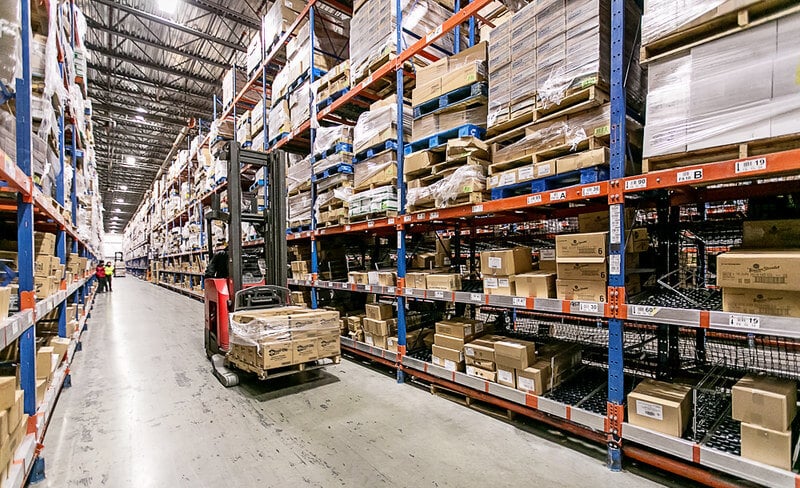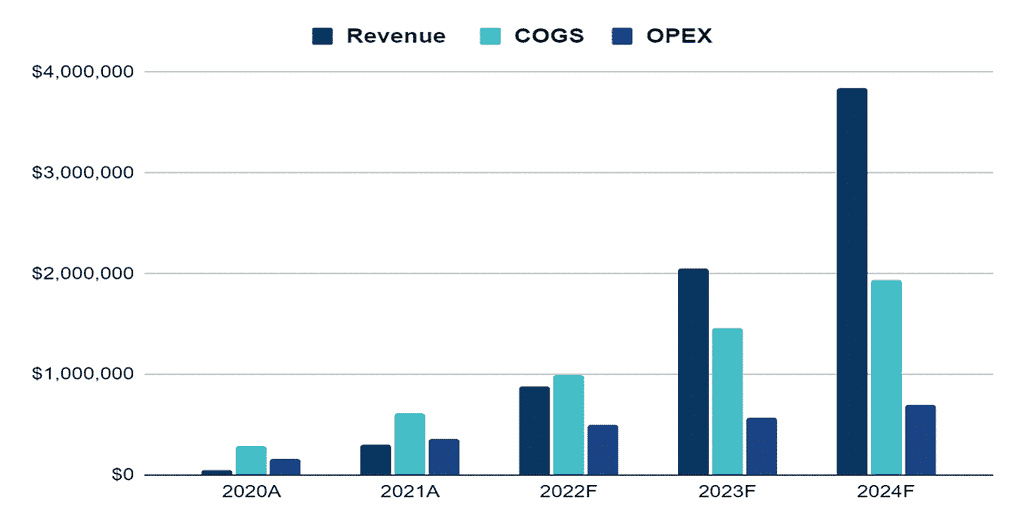Written by Elma Steven | Updated on April, 2024

How to Write a Warehouse Business Plan?
Warehouse Business Plan is an outline of your overall Warehouse business. The business plan includes a 5 year projection, marketing plan, industry analysis, organizational overview, operational overview and finally the executive summary. Remember to write your executive summary at the end as it is considered as a snapshot of the overall business plan. The creation of a plan requires careful consideration of various factors that might impact the business’s success.
Table of Contents
Executive Summary
EfficientWare Logistics is a dynamic and innovative warehouse solution provider aimed at addressing the increasingly complex challenges faced by businesses in managing their supply chains and storage operations. The global logistics industry is undergoing rapid transformation, our company is poised to deliver cutting-edge warehouse services that optimize storage, streamline distribution and reduce operational costs. This business plan outlines the compelling problems we aim to solve and the innovative solutions we offer, positioning EfficientWare Logistics as the premier choice for warehousing and distribution needs.
Mission: EfficientWare Logistics is dedicated to revolutionizing the logistics and warehousing industry by providing innovative, efficient and environmentally responsible storage and distribution solutions. Our mission is to empower businesses with the tools they need to optimize their supply chain operations, reduce costs and enhance their competitiveness on a global scale, all while minimizing their environmental impact.
Vision: Our vision is to be the foremost leader in the warehousing and logistics sector, setting the standard for excellence in storage, distribution and sustainability. We aspire to create a future where companies of all sizes can effortlessly navigate the complexities of global supply chains, significantly reduce their operational expenses and contribute to a greener, more sustainable world through their logistical activities.
Industry Overview: The worldwide warehousing industry is anticipated to be worth over $278 billion in 2023 and will increase at a CAGR of 7% from 2020 to 2024, reaching roughly $326 billion. Due to tight supply circumstances and increasing technological adoption, Europe, North America, and APAC nations such as Australia and Singapore have advanced market maturity. Due to a projected increase in manufacturing facilities, robust growth of the e-commerce sector, a high number of top container ports, and which will grow from $97 billion in 2020 to $143 billion in 2024, parts of APAC, such as India and China, are expected to be future growth driving markets for the warehousing industry. There are three degrees of market maturity in the sector, and this research divides the warehousing market into three categories: High Market Maturity, Medium Market Maturity, and Low Market Maturity nations.
Check out this guide on how to write an executive summary? If you don’t have the time to write on then you can use this custom Executive Summary Writer to save Hrs. of your precious time.
Financial Overview

Business Description
Business Name: EfficientWare Logistics
Founders: Jacob Harrison
Management Team:

Legal Structure: EfficientWare Logistics LLC
Location: Sunnydale, California, USA
Mission: “EfficientWare Logistics is dedicated to revolutionizing the logistics and warehousing industry by providing innovative, efficient and environmentally responsible storage and distribution solutions. Our mission is to empower businesses with the tools they need to optimize their supply chain operations, reduce costs and enhance their competitiveness on a global scale, all while minimizing their environmental impact.”
Vision: “Our vision is to be the foremost leader in the warehousing and logistics sector, setting the standard for excellence in storage, distribution and sustainability. We aspire to create a future where companies of all sizes can effortlessly navigate the complexities of global supply chains, significantly reduce their operational expenses and contribute to a greener, more sustainable world through their logistical activities.”
Goals:
- Operational Excellence: Strive for operational excellence by consistently providing efficient and innovative warehousing solutions that exceed client expectations.
- Cost Savings: Help clients achieve substantial cost savings by leveraging automation, process optimization and sustainable practices in their warehousing operations.
- Sustainability: Lead the industry in environmentally responsible practices by reducing our carbon footprint and promoting eco-friendly initiatives across our services.
- Global Reach: Expand our reach to become a global provider of warehousing and distribution solutions, serving businesses across diverse industries.
- Customer Satisfaction: Maintain a high level of customer satisfaction by ensuring that clients have the tools and support they need to thrive in an ever-evolving market.
- Innovation: Continually invest in cutting-edge technologies and best practices to remain at the forefront of industry innovation.
Products:
- Optimized Warehousing: Cutting-edge warehouses designed to maximize space and efficiency while enhancing inventory management.
- Cost-Effective Operations: Solutions to reduce operational costs through automation, energy management and process efficiency.
- Advanced Inventory Management: Software and systems providing real-time inventory visibility, demand forecasting and automated replenishment.
- Global Integration: Seamless integration into global supply chains with real-time connectivity, end-to-end visibility and scalability.
- Environmental Sustainability: Sustainable warehousing practices, green technologies, energy-efficient systems and eco-friendly packaging solutions to meet sustainability objectives.
Get the Free Business Plan Template
Get the template over email
Financial Overview
Key Metrics

Business Model Canvas

SWOT

Organizational Overview
Founder
Jacob Harrison
Founder/ CEO
Jacob Harrison is the visionary founder and driving force behind EfficientWare Logistics. With a rich background in logistics, entrepreneurship and a passion for sustainable business practices, Jacob brings a wealth of experience and expertise to his role as the founder of the company.
Jacob’s journey in the logistics industry began early in his career when he worked as a logistics coordinator for a global e-commerce giant. His innate ability to identify inefficiencies and drive process improvements led to rapid advancements within the company. Inspired by this experience, he sought to create a company that would redefine warehousing and distribution practices.
Jacob’s academic background includes a Bachelor’s degree in Business Administration, which he pursued while working full-time, showcasing his dedication and commitment to continuous learning and personal growth. This combination of hands-on experience and formal education has provided him with a well-rounded skill set that is vital to the success of EfficientWare Logistics.
What truly sets Jacob apart is his unwavering commitment to environmental sustainability. He is a staunch advocate for eco-friendly practices in the logistics industry and is deeply invested in reducing the carbon footprint associated with warehousing and transportation. His vision for EfficientWare Logistics goes beyond financial success; it’s driven by a desire to make a positive impact on the environment.
Jacob’s leadership style is characterized by a strong emphasis on innovation and teamwork. He fosters a culture of constant improvement and encourages his team to explore and embrace cutting-edge technologies and sustainable initiatives. His ability to inspire and lead a dedicated and passionate team is instrumental in the company’s success.
In founding EfficientWare Logistics, Jacob Harrison brings a blend of practical experience, academic knowledge and an unshakable commitment to sustainability. With his leadership, the company is poised to deliver innovative, cost-effective and eco-friendly warehousing solutions that address the challenges faced by businesses in today’s ever-evolving global marketplace.
Organogram
Staff Positions
Spending on Management & Operations:
Spending on Marketing & Sales:
Spending on Finance & Accounting:
Industry Analysis
Industry Overview
The warehousing and logistics industry is a pivotal component of the global supply chain, playing a critical role in facilitating the efficient movement of goods from manufacturers to end consumers. EfficientWare Logistics aims to disrupt and excel in this highly competitive sector by providing innovative and sustainable warehousing solutions.
Problems & Opportunities
- Operational Efficiency: Inefficient storage practices, misplaced inventory and underutilized space remain pervasive issues that hamper operational efficiency, increase costs and waste resources.
- Rising Operational Costs: Escalating expenses in labor, real estate and energy have put substantial pressure on logistics companies to find innovative ways to reduce costs without compromising service quality.
- Environmental Regulations: Evolving environmental regulations and increased scrutiny on sustainability necessitate the adoption of green technologies and practices, often requiring significant investments.
- Competition: The industry is highly competitive, with established players and new entrants, making it challenging for newcomers to differentiate themselves and gain market share.
- E-commerce Growth: The expansion of online retail and the need for efficient e-commerce fulfillment centers present significant growth opportunities for the company.
- Sustainability Focus: The company’s commitment to environmentally responsible practices aligns with the industry’s shift toward sustainability, appealing to businesses that seek to reduce their environmental impact.
- Global Expansion: EfficientWare Logistics can leverage its expertise to expand its services to new geographic regions, catering to the growing demand for international logistics solutions.
- Technology Advancements: Continuous advancements in technology offer the opportunity to enhance services, improve automation and provide data-driven insights for clients.
Target Market Segmentation
- Geographic Segmentation:
- Local Businesses: We serve local businesses in the vicinity of our warehousing facilities, offering them proximity and ease of access for their storage and distribution needs.
- Regional Operations: For companies with regional distribution networks, our strategically located warehouses provide efficient storage hubs that are within a few hours’ drive of key destinations.
- Global Enterprises: Multinational corporations and global brands benefit from our global integration capabilities, seamlessly connecting our warehousing services to their worldwide supply chains..
- Demographic Segmentation:
- Small to Medium Enterprises (SMEs): SMEs often have unique warehousing requirements and typically seek cost-effective solutions. Our services are tailored to meet their specific needs and budget constraints.
- Large Corporations: Major corporations with substantial warehousing needs are attracted to our state-of-the-art facilities, which offer advanced inventory management, scalability and efficiency.
- Psychographic Segmentation:
- Eco-Conscious Businesses: Companies that prioritize environmental sustainability are drawn to our commitment to eco-friendly warehousing practices, making us a preferred partner for those looking to reduce their carbon footprint.
- Tech-Forward Enterprises: Businesses that embrace technology and automation as a means to improve efficiency and accuracy in their supply chain operations find our integrated inventory management solutions particularly appealing.
- Behavioral Segmentation:
- Cost-Conscious Clients: Companies that seek to reduce operational costs and improve their bottom line are interested in our cost-effective warehousing solutions, as they offer substantial savings while maintaining quality.
- Efficiency-Seeking Organizations: Clients who value streamlined and organized storage practices, precise inventory management and reduced lead times are attracted to our services, which enhance their overall operational efficiency.
- Global Integration Clients: Enterprises with complex global supply chain operations and intricate transportation networks benefit from our global integration capabilities, allowing them to adapt to changing market demands effectively.
Market Size
- Total Addressable Market (TAM): The Total Addressable Market for EfficientWare Logistics is extensive, encompassing all businesses across different industries that require warehousing and logistics services. Estimating conservatively, the global logistics market is valued at over $4.5 trillion and the warehousing sector constitutes a substantial portion of this. Our TAM includes small to large enterprises, with our services catering to local, regional and international businesses. Thus, the TAM is estimated to be in the range of $300 billion to $500 billion annually.
- Serviceable Addressable Market (SAM): The Serviceable Addressable Market is a subset of the TAM, focusing on the segments that our company can effectively target and serve. We will initially focus on local and regional businesses that require warehousing and distribution solutions, as they align with our current operational capabilities. This represents a SAM of approximately $50 billion to $70 billion annually, which is the portion of the TAM that we can realistically reach.
- Serviceable Obtainable Market (SOM): The Serviceable Obtainable Market narrows our target to the specific segments within the SAM that we intend to capture. In our initial stages, we aim to capture a conservative market share of 5%. This represents a SOM of approximately $2.5 billion to $3.5 billion annually, reflecting our realistic expectations for growth and market penetration within the local and regional business segments.
Competitive Landscape
- Traditional Warehousing Providers: Established players in the warehousing industry offer traditional services and have a loyal customer base. They may not always adopt the latest technologies and sustainability practices, which presents an opportunity for differentiation.
- Global Logistics Giants: Large logistics companies with extensive international networks have a strong presence in the market. They offer end-to-end supply chain solutions and integrated warehousing services.
- E-commerce Fulfillment Providers: Companies specializing in e-commerce fulfillment and distribution, such as Amazon, are formidable competitors, especially in the rapidly growing e-commerce segment.
- Specialized Warehousing Providers: Some companies offer niche warehousing services, catering to specific industries or storage requirements, which can pose competition in select market segments.
- New Entrants and Startups: Smaller, innovative startups that leverage cutting-edge technology and sustainability practices aim to disrupt the industry by providing flexible, cost-effective solutions.
Porter’s 5 Forces
- Threat of New Entrants:
Low Threat: Entering the warehousing industry requires substantial initial investments in infrastructure, technology and talent. Regulatory compliance and sustainability standards also pose barriers to entry.
- Bargaining Power of Suppliers:
Moderate: Suppliers of warehousing equipment, automation technology and sustainable materials hold some bargaining power. However, as technology advances, suppliers may have to adapt to meet the evolving needs of logistics companies.
- Bargaining Power of Buyers:
High: Buyers, including businesses of all sizes, have high bargaining power due to the abundance of warehousing providers. They can negotiate on pricing, service levels and sustainability practices, making differentiation and value crucial.
- Threat of Substitutes:
Low: There are limited substitutes for warehousing and logistics services, especially for businesses with complex supply chains. Efficient alternatives are scarce, cementing the industry’s importance.
- Rivalry Among Existing Competitors:
High: Intense competition among established players, global logistics giants, e-commerce giants, niche providers and startups drives frequent innovation, cost reduction efforts and sustainability practices. Market players must continuously differentiate themselves to maintain or gain market share.
Marketing Plan
Marketing Budget
Total budget for projected years:
Budget allocation across channels:
Marketing Channels
We plan to use the following promotional tactics:
- Online Presence:
- Website: A professionally designed website will serve as the central hub for information about our services, case studies and contact details. It will also facilitate online inquiries and bookings.
- Search Engine Optimization (SEO): Implementing SEO strategies to enhance our website’s visibility in search engine results pages when potential clients search for warehousing and logistics services.
- Content Marketing: Regularly publishing blog posts, whitepapers and articles on relevant industry topics to position EfficientWare Logistics as an authoritative source and attract organic traffic.
- Social Media:
- LinkedIn: Leveraging the professional network of LinkedIn to establish a thought leadership presence, connect with industry professionals and share industry insights.
- Twitter and Facebook: Utilizing these platforms for broader brand awareness and sharing updates, sustainability initiatives and engaging content.
- Email Marketing: Sending informative newsletters, updates and promotional materials to a carefully curated email list, which includes leads and existing clients, to maintain engagement and foster client relationships.
- Trade Shows and Conferences: Participating in industry-specific events to showcase our services, network with potential clients and stay updated on industry trends.
- Partnerships and Referrals: Collaborating with suppliers, logistics partners and other businesses in related industries to cross-promote services and obtain referrals.
- Direct Sales and Telemarketing: Employing a dedicated sales team to reach out to potential clients directly through phone calls, emails and in-person meetings, highlighting the unique value we offer.
- Print and Online Advertising: Utilizing both print and online advertisements in industry publications and platforms to increase brand visibility and attract leads.
- Client Testimonials and Case Studies: Showcasing success stories and testimonials on our website and marketing materials to build trust and credibility.
- Industry Associations and Networking: Active involvement in warehousing and logistics industry associations and groups to establish relationships with potential clients and partners.
- Geo-Targeted Advertising: Implementing location-based advertising campaigns to reach local businesses seeking warehousing and logistics services.
Financial Statements
Earnings
Income Statement

Balance Sheet

Cash Flow Statement

Revenue Summary

Cost Summary

Loan Amortization Schedule

Salary Summary

Non-Current Asset Schedule

Income Statement

